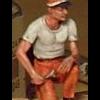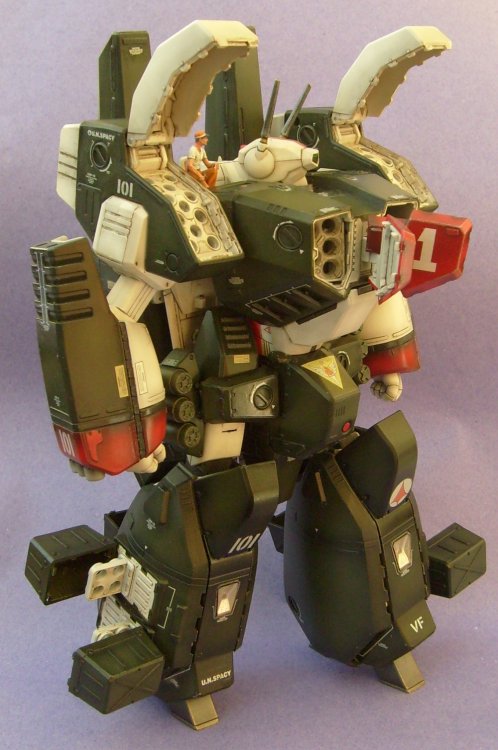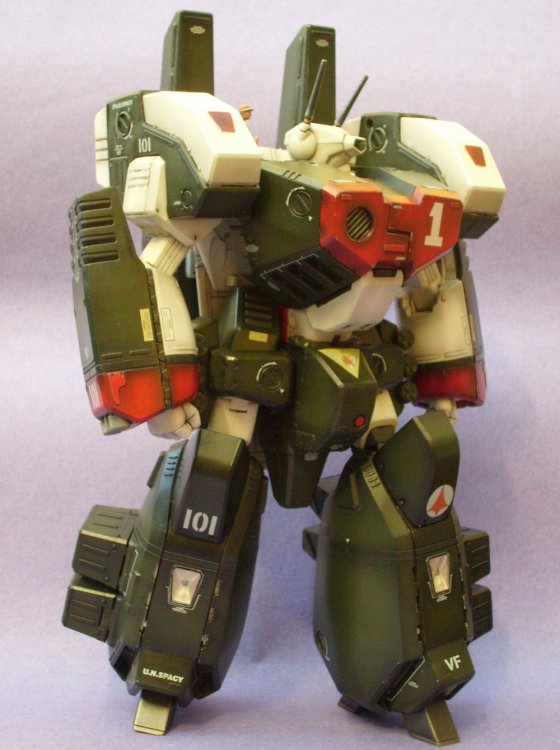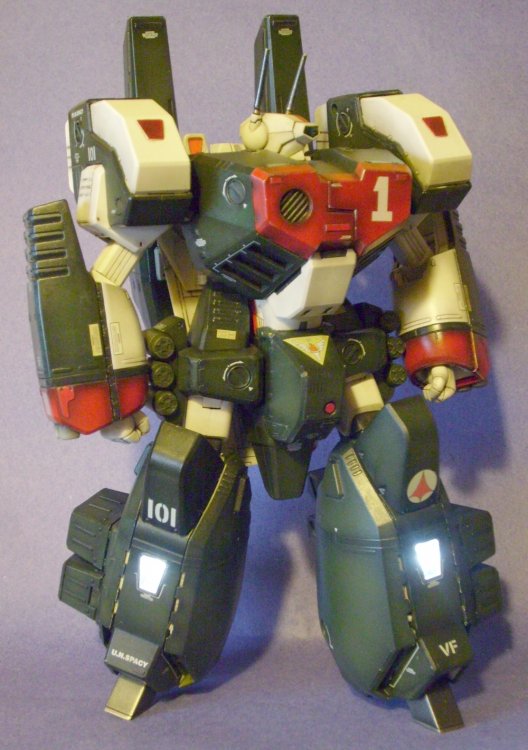-
Posts
189 -
Joined
-
Last visited
Content Type
Profiles
Forums
Events
Gallery
Everything posted by winterdyne
-

How do I disassemble the intakes on a 1/48?
winterdyne replied to magicsp00n's topic in The Workshop!
I didn't dismantle that part on my 1J. I repainted the turbine by hand - first with a couple of coats of thin dark grey, then a drybrush up, then gloss and oilwash with everything else. -
Machine mart do an all-metal dual action airbrush very cheaply (about £18 IIRC). That'd do the trick. Unusual for an airbrush to 'pack up' - what was it?
-
Not being familliar with the model, can't say for sure, but a good idea is usually to lightly tack together sub-assemblies that need to be shaded as a whole. Depending on how the joints are made you may be able to mask after assembly but it could be tricky.
-
From what I can see you've got plenty of space to work with. This is assuming that you want an 'invisible' fix. Takes a bit of work, but this should be pretty indestructible when you're done. I'm also sure some of this is second nature, but to some folks it might not be. I'd suggest you glue (with epoxy or something else very strong) some blocks of plastic up to just under (.5mm) the level of the mating surfaces on both sides of the leg. Don't forget to roughen the surface first - scratch and burr it up with the point of a knife. Next - Pinning. Pinning is best done by having the wire clipped into much longer lengths than needed (but small enough to handle - about 1inch / 2cm is fine), then once glued into the first set of holes, use a pair of wire cutters to snip 'em to the right length. Drill pin holes straight in to a depth of about 5mm. Apply a small amount of epoxy to the holes, and insert pins. Clean any excess by drawing it with a toothpick toward the inside of the part. This stops strings being draped over the visible bits of the part. Ensure they're straight, allow to dry then clip, leaving around 3-5 mm exposed. Now 'ink' the ends - put a spot of (oily) paint on the exposed end of the pin, and fit the part. This will mark on the other block where you need to drill for the pins to go in. Dunno where I learned this, nobody else I know does this, but I find it really useful. Drill those *slightly* deeper than required and apply epoxy to the surface of the block with a toothpick, covering the holes, and bringing it to the mating surface level. Do NOT apply epoxy to the other block Again, work towards the inside of the part. What will happen is when you assemble the part the pins will push a little (enough) of the epoxy into the hole to hold them in place and the remainder should be displaced upward to contact the other block without having so much that it oozes out and makes a horrible seam. Hope this helps. :-) Edit: Just because the solvent softens the plastic doesn't mean it'll glue it. Otherwise everyone would use paint stripper instead of plastic cement. The question is does it go tacky, or just dissolved? I strongly suggest an inert adhesive like epoxy or CA.
-
Can you put up a pic of the damaged part and how it's meant to close? I don't have a '19 but I'm generally pretty good at making fairly invisible repairs... EDIT: Do NOT attempt to make the repair with an untried solvent! If unsure, try a little with a q-tip / matchstick on an inside surface. If the plastic melts too much you'll just end up with a wider gap that's harder to hide.
-
I use Daler-Rowney Low Odour Thinners (for oil colour). Doesn't seem to attack the future, and doesn't stink.
-
The primary requirement is the ability to print in white. Up till fairly recently this was only provided by ALPS / OKI sublimation printers, but now there are laser printers that can deposit an opaque white toner (link in previous post). This requires TWO printers. One for the colour dyes, and one for the white (as the colour may stick to the rollers and contaminate a white finish). Printing is therefore a two stage process (on clear waterslide decal film) - first the white layer is printed then that is run through the colour printer. Not sure how accurate the alignment is, but the sample prints I got looked ok. The downside is that laser printers can't do the metallic colours (silver, gold) that the ALPS ribbon printers used to, so they're not so useful for the railway modellers that use those colours.
-
I was thinking about it a while back, but it was a no-go. Simply couldn't get enough cash together to buy the kit (from www.atttranfser.com). Somewhere there's a poll that I used to gauge interest just from this site, and while it wouldn't cover the outlay, it was still fairly significant. Devin had also agreed to allow the use of his sheet designs, so for the macross stuff it could have been ready to go fairly quickly.
-
For preshading you can't beat a dual action airbrush. You can get them at machine mart, about £15. Way, way cheaper than a model shop. Do NOT use white spirit to thin oils for a wash. Get low odour thinner, hobbycraft has it. If you're just getting into doing preshades (or any paintwork blending technique) is to use lower contrast blends - this means for white you'd preshade with grey, not black. It means you do fewer coats and can overpaint errors more easily. Drybrushing... you need a soft brush. VERY soft. And you need to dry it thorouhly - it should leave almost no paint when drawn across the back of your hand. The worst thing you can do is attempt to drybrush with too much paint - you'll get a streaky finish for sure.
-
Mmm... I'd dearly like one of these... does anyone know if Bandai are planning on producing waterslide / dry transfers rather than stickers for their collectors' toys, like the Yamato ones that are supposed to be about soon?
-
I've only done the one valk, but it turned out nice, and the paintwork is wearing very well. The transfers, not so good, especially on the intakes where the GBP armour is a little tight. If you're doing a full repaint, sanding and priming are the most important part. I used 600 and 1200 grit papers, and primed with Citadel (Games Workshop) Skull white from a rattlecan. My actual paint was Tamiya acrylic (thinned with the proper thinners). Sealed with future, tranferred, then sealed again, then oil washed, then flat coated with 'flat future' - a 30-70 mix of Tamiya flat base and Future. (Klear in the UK). On the yammies, pay particular attention to the verniers on the intakes (where they rub the upper leg), the surfaces of the hinges on the arms and legs, the knee cover sides and all over the forearms. Those areas all get a lot of handling, so you absolutely need good paint adhesion. Do this whilst the valk is disassembled and keep dry fitting to ensure a moderately loose fit. I put all this stuff in a writeup in a thread a few months back.
-
Unless you're working from a real-world blueprint, you can bet your bottom dollar that scale wasn't an issue in the design process. I've done a fair amount of remodelling of Warhammer 40,000 titans to get them in Dawn of War, and going from what's a static, sculpted model to something that has to move requires the same sort of fudging as going from anime lineart to a sculpted product does - these things are designed to look cool in a certain shot, or pose and trying to put a 'bigger picture' together reveals the inconsistencies. I can only really echo the advice given by others - go with what looks right to you, and does what you want. If a compartment can't open the way it's intended to when tried, does it matter if it's not going to be opened and looks ok where it is? Finding where to modify proportions to achieve what you want is half the fun of modelling an object designed for another purpose. You might want to use a computer modelling package to play with the proportions in 3D. I've done that a lot for cardstock models (even taking measurements off my 3d model) to make templates. It can help a great deal.
-
-
If you want someone to er... 'test paint' a prototype... ;-) j/k, I've been following this with interest, hope it comes to fruition!
-

VF-0S Battleroid Weathering. Second time around.
winterdyne replied to Sonic's topic in The Workshop!
Bravo! Very nice job - good to see those seam lines gone or at least reduced massively. Preshade looks good too, I know you were unsure about it at first, but its turned out really well. -
Oh, there's also some step-by-step photos in the photo album at http://www.scifimodels.org.uk/
-
Nausica: With the yamato, check my customising thread for some tips, especially involving the canopy. Other than that, you need to use a dremel / rotary grinder on a few joints to get clearance for the paintwork. I've transformed mine maybe half a dozen times now and have minimal wear - mostly from my long fingernails. Remember to use a good clear coat (future!) to seal paintwork and decals, and again after weathering, then a flat coat and it'll be remarkably durable. I'd strongly advise against hand painting - use an airbrush, the plastic is fairly textured and will look odd if your paint finish isn't even.
-

Recasts of 1/100 Armored Factory vehicles - volunteer?
winterdyne replied to AcroRay's topic in Model kits
I'd really like to look at working these up in 1/48. If you get them recast, I'd like some too! -
I'd love a 1/48 Cat's Eye. Especially if it had nice landing gear, I like my planes gear down.
-
Future works well both with an airbrush and brushed on by hand. Oh, for a flat coat, mix it with Tamiya Flat Base (X-21). Works brilliantly and is a damn sight cheaper than any comparable matte varnish / topcoat I've seen.
-
Future is sold under a lot of different names. Check out Swanny's 'The Complete Future' (google it) for local names and retailers and tricks to do with the stuff. Oh, it's a supposed floor cleaning product / polish, not a modelling product, paint or varnish. Most places I know that sell it put it near the window cleaning products too (which is handy as you use those to clean up the stuff).
-
More photos added to the GBP custom thread. Not putting them here. They're big.
-
Here for the progress thread including buildup info. Here for the completed thread for the fighter. I just slap stuff into this thread when I think I have something notable to show, and never as many pics as in the buildup threads.
-
They've got super-bright LED's mounted in them. The conversion is really simple, and I've got a full step-by-step in my progress thread. The only tricky part is applying the silver foil to the back of the lenses. Looks ace in the display case (which has a centre-mounted spotlight in the top so the legs remain mostly dark, showing off the light. Will try to grab a pic tonight.
-
Amen. And breathing a lungful of thinner in the hope of dissolving the paint coating your airways is not a great idea - a disposable DIY sanding mask can be disposed of when gunked up. Lungs are trickier. Advice I'll always echo, even if I don't always follow it, I know I should.



